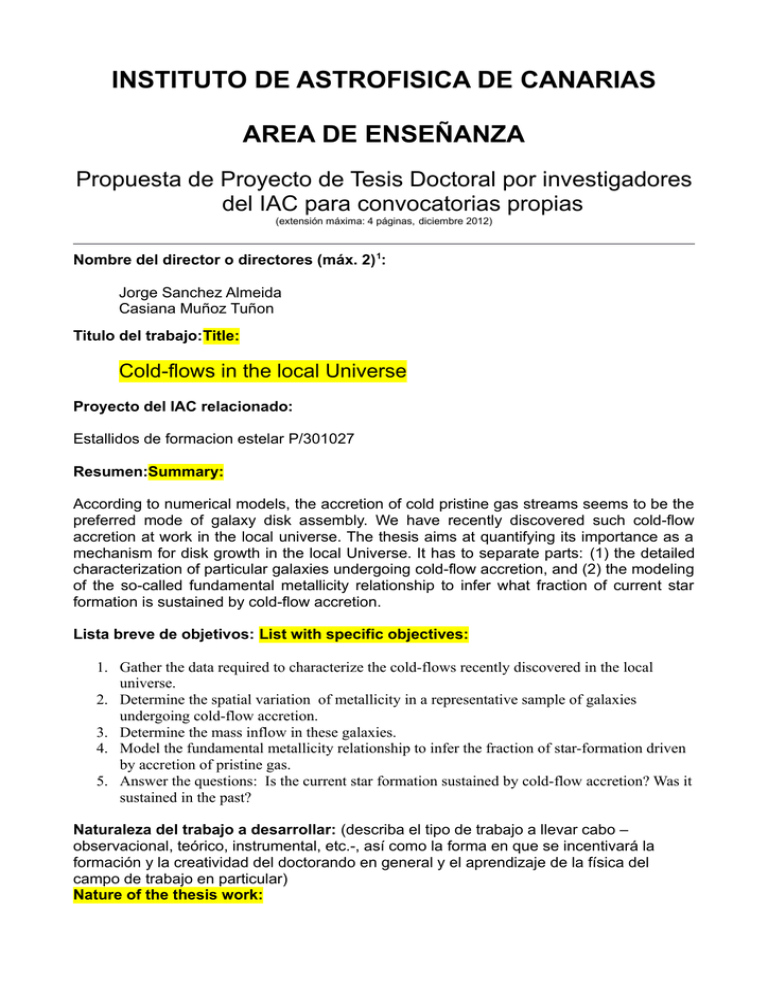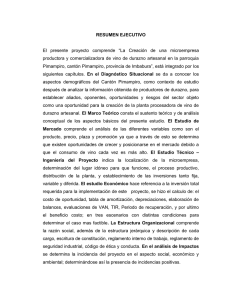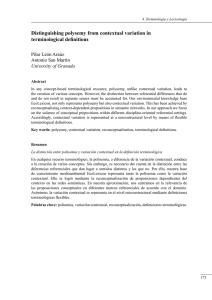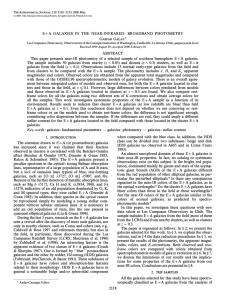he actual project
Anuncio

INSTITUTO DE ASTROFISICA DE CANARIAS AREA DE ENSEÑANZA Propuesta de Proyecto de Tesis Doctoral por investigadores del IAC para convocatorias propias (extensión máxima: 4 páginas, diciembre 2012) Nombre del director o directores (máx. 2) 1: Jorge Sanchez Almeida Casiana Muñoz Tuñon Titulo del trabajo:Title: Cold-flows in the local Universe Proyecto del IAC relacionado: Estallidos de formacion estelar P/301027 Resumen:Summary: According to numerical models, the accretion of cold pristine gas streams seems to be the preferred mode of galaxy disk assembly. We have recently discovered such cold-flow accretion at work in the local universe. The thesis aims at quantifying its importance as a mechanism for disk growth in the local Universe. It has to separate parts: (1) the detailed characterization of particular galaxies undergoing cold-flow accretion, and (2) the modeling of the so-called fundamental metallicity relationship to infer what fraction of current star formation is sustained by cold-flow accretion. Lista breve de objetivos: List with specific objectives: 1. Gather the data required to characterize the cold-flows recently discovered in the local universe. 2. Determine the spatial variation of metallicity in a representative sample of galaxies undergoing cold-flow accretion. 3. Determine the mass inflow in these galaxies. 4. Model the fundamental metallicity relationship to infer the fraction of star-formation driven by accretion of pristine gas. 5. Answer the questions: Is the current star formation sustained by cold-flow accretion? Was it sustained in the past? Naturaleza del trabajo a desarrollar: (describa el tipo de trabajo a llevar cabo – observacional, teórico, instrumental, etc.-, así como la forma en que se incentivará la formación y la creatividad del doctorando en general y el aprendizaje de la física del campo de trabajo en particular) Nature of the thesis work: The work is multidisciplinary. It involves the analysis of new observations, but also needs of using chemical evolution models to interpret the observed relationship between starformation rate and metallicity. Carrying out the work will force the student to become familiar with most of the techniques used in modern extra-galactic astronomy. The student will have to observe and reduce data from major astronomical facilities, as well as to write observing proposals. He/she will have to become familiar with the techniques to measure masses, star-formation rates and metallicities. Photometry and spectroscopy will be employed as tools, and the observations will have to be interpreted in terms of theoretical models (e.g., population synthesis models to estimate stellar ages and metallicities). If the student becomes proficient in all these fields, a future in professional astronomy is guaranteed. Learning how to deal with all this techniques and tools may sound a bit too much for a PhD student, however, the thesis will be developed in a large group with world-wide experts in every aspect of the work, and they are willing to help. Skillful hardworking students will find the environment exciting and supportive. Creativity is very hard to stimulate and extremely easy to suffocate by the competitive atmosphere of professional research, where quantity often prevails over quality. The proponents are proud of appreciating the value of imagination in science, and they will do their best to preserve the natural student's creativity. Memoria del proyecto: (incluyendo una descripción general del trabajo a desarrollar y un plan de trabajo con plazos temporales. Aquí pueden y deben aparecer otros colaboradores del grupo.) Scientific Rationale: The formation of disks is a critical but poorly understood process in the assembly of all galaxies – even massive ellipticals are produced by mergers of protodisks. Disk formation is predicted to start early in the Universe, however the process never shuts off completely. According to numerical modeling, disks build up from gas accretion which may proceed in two different ways (e.g., Silk and Mamon 2012): (1) the so-called 'cold-flow' accretion along cosmic web filaments, that feed the disks with fresh clumpy pristine gas ready to form stars. And (2), a more gentle isotropic rain of originally hot gas trapped in the galactic halo that cools down and continuously feeds the disk. The relative importance of the two modes is unknown, but it turns out to be a matter of raging debate in the current literature (cf., e.g., Dekel et al. 2009 and Hopkins et al. 2013). We have recently discovered that cold-flows are still active in the local universe (Sanchez Almeida et al. 2013). The thesis project follows up on this finding, and it is aimed at quantifying what fraction of the current star formation is sustained by cold-flow accretion. Comparison with model predictions will allow to assess the importance cold-flows all the way back to the origin of the Universe. The cold-flows fuel star formation with low metallicity gas. Therefore, observationally, they show up as enhanced star formation activity in galaxy regions of reduced metallicity (e.g., Cresci et al. 2010). We have found this characteristic signature in local 'tadpole' galaxies. Such galaxies, with a bright head on a faint tail, turn out to have a morphology common in the early Universe (e.g., van den Bergh 1996, Elmegreen et al. 2005) but rare today (Elmegreen et al. 2012). They are thought to be primitive disks in the process of being assembled. Tadpole galaxies are close relatives of another family of rare objects, the socalled extremely metal poor galaxies or XMP galaxies, defined as those galaxies whose star-forming gas has a metallicity less than a tenth the solar value. They represent only 0.1% of all local galaxies (Morales-Luis et al. 2011). The two families are akin because XMP galaxies have a preference for the tadpole-cometary shape (Papaderos et al. 2008, Morales-Luis et al. 2011) and vice versa, i.e., tadpoles are often XMP (Sanchez Almeida et al. 2013). This association between morphology and low-metallicity was very unexpected when it was found, however, it fits in well the cold-flow accretion scenario. The lowmetallicity tadpole head would be a starburst triggered by a recent cold-flow accretion episode on a quiescent metal-richer disk galaxy. In view of their importance as tracers of cold-flow accretion in the local universe, we are embarked in the full chemo-dynamical characterization of a representative set of XMPtadpole galaxies (some 10% of all known objects). We aim at securing the existence of cold-flow accretion by accurate measurements of their metallicity gradients, and then at quantifying the physical properties of the underlying galaxies. In addition, we try to detect the cold-flows directly as the gas falls into the galaxies – using high spatial resolution neutral gas maps to detect the gas streams directly (HI taken with VLA), and using high spatial resolution Hα images to detect the streams illuminated by the galaxy (HST data). This project is pursued by an international collaboration coordinated from the IAC, which gathers experts in all required fields from metallicity determination to galaxy formation, and from optical to radio observations: among others, Amorin, Ascasibar, Elmegreen, Elmegreen, Filho, Papaderos, and Vilchez. The student is expected join in and participate in the project. More specifically, in the gathering, reduction and analysis of the optical data that will provide the metallicity gradients so critical in this context. (These data are partly available.) One may naively think that XMP-tadpole galaxies are rare objets undergoing a physical process that may have been important in the past, but which is now irrelevant. This does not seem to be the case. The metallicity and the star-formation rate (SFR) of any typical local star-forming galaxy are anti-correlated, just as expected if the current star formation has been triggered by the advent of metal poor gas. The behavior is reflected in the socalled fundamental metallicity relationship (FMR, Mannuci et al. 2010, Lara-Lopez et al. 2010), but other empirical relationships show it as well (e.g., the metallicity of the quescent BCDs is higher than the metallicity of the BCDs; Sanchez Almeida et al. 2008, 2009). During the thesis, we plan to model this FMR using chemical evolution models (e.g., Edmunds 1990) to quantify which fraction of the relationship could be explained by recent accretion of pristine gas. It will yield the fraction of star-formation driven by cold-flow accretion in the local Universe, which is the ultimate goal of the thesis project. References: Cresi, Mannucci, Maiolino et al. 20102010Natur.467..811C Dekel, Birnboim, Engel et al. 2009Natur.457..451D Edmunds 1990MNRAS.246..678E Elmegreen, Elmegreen, Rubin, et al. 2005ApJ...631...85E2005 Elmegreen, Elmegreen, Sanchez Almeda et al. 2012ApJ...750...95E Hopkins, Keres, Murray, 2013arXiv1301.4500H Lara-Lopez, Cepa, Bongiovanni, et al. 2010A&A...521L..53L2010 Mannucci, Cresci, Maiolino et al. 2010MNRAS.408.2115M Morales-Luis, Sanchez Almeida, Aguerri et al. 2011ApJ...743...77M Papaderos, Guseva, Izotov et al. 2008A&A...491..113P van den Bergh, Abraham, Ellis et al. 1996AJ....112..359V Sanchez Almeida, Muñoz-Tuñon, Amorin et al. 2008ApJ...685..194S Sanchez Almeida, Aguerri, Muñoz-Tuñon et al. 2009ApJ...698.1497S Sanchez Almeida, Muñoz-Tuñon, Elmegreen, et al. 2013arXiv1302.4352S Silk & Mamon 2012RAA....12..917S Acronyms: BCD: Blue Compact Dwarf (galaxy) FMR: Fundamental Metallicity Relationship GTC: Gran Telescopio Canarias HST: Hubble Space Telescope VLA: Vary Long Array WHT: William Hershel Telescope Specific Work, instrumentation and timescales: The thesis work will have four phases, each one of which is expected to last one year. The first year is not research-wise demanding, because the student is expected to devote a significant part of his/her time attending PhD courses. Year 1.- Carrying out the observations for the time already allocated to the team, and starting the reduction and analysis of the data available. (Co-)writing observing proposals for GTC, WHT, HST and VLA to complete the sample. Year 2.- Determine the physical properties from the spectra. The metallicity estimate is the central part of the analysis and it will have to be taken care of with special care. A visit to Granada and/or Porto may be needed. Co-Write a first paper. Year 3.- Model the FMR in terms of cold flow accretion. Model the excess of metals of quiescent BCDs in terms of cold-flow accretion. Co-write a second paper. Year 4.- Thesis writing and defense, which should address these three specific questions: (1) Is cold-flow accretion taking place on the local universe beyond any doubt? (2) What is fraction of current star formation sustained by cold-flow accretion? (3) What was it in the past? Co-write a third paper. Si existe algún elemento de riesgo, más allá de lo habitual, en el proyecto propuesto, descríbalo junto con las acciones que se proponen para mitigarlo. None. Part of the required data are already available, and the thesis has a important modeling component with all the tools available. Experiencia de los directores en el tema de investigación: The IAC starburst group lead by one of us (CMT) has an ample experience both in extragalactic astronomy, and in supervising PhD students. It is extremely well considered by funding agencies because of its size and sinergies with other groups. Details of the group, research and publications can be found in the group webpage, http://www.iac.es/proyecto/GEFE/portal.html Moreover, we have pioneered the detection of cold flows in the local Universe, and so we are in particularly good shape to try to quantify their properties, which is the main goal of the thesis. Tesis leídas y dirigidas por los directores en los últimos 5 años: 1. R. Amorin, 2008, La galaxia anfitriona de las galaxias compactas azules, dir: CMT+ 2. R. Sanchez Janssen, 2009, Morfología y formación estelar de las galaxias en cúmulos cercanos, CMT+ 3. I. Martinez Delgado, 2009, Impacto de la formacion estelar en galaxias compactas azules, CMT+ 4. A. Morales-Luis, to be read this year, Search and Characterization of galaxies with the lowest metallicity, dir: JSA, CMT+ Si alguno de los directores tiene un estudiante de primer año, justifique la necesidad del estudiante que se pide, la no interferencia entre ellos y la capacidad para dirigirlos simultáneamente: Si alguno de los directores tiene un estudiante de quinto año o mayor, comente este hecho negativo y la capacidad para dirigirlos simultáneamente: Nota final: las comisiones encargadas de evaluar el proyecto considerarán obligatoriamente, entre otros, los siguientes criterios de valoración: • Capacidad de los directores para dirigir tesis doctorales. • • Calidad científica del proyecto y experiencia de los directores en el tema. Situación de otros doctorandos en el grupo.





![−10 0 10 20 Dec[arcsec] −10 0 10 20 Dec[arcsec] 1993R 2014cy](http://s2.studylib.es/store/data/006588599_1-c53d6943a09ad7d4952a441ade3bcf51-300x300.png)
